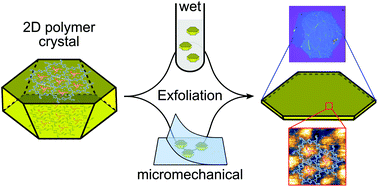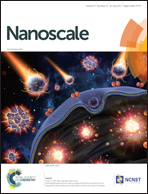Exfoliation of two-dimensional polymer single crystals into thin sheets and investigations of their surface structure by high-resolution atomic force microscopy†
Abstract
The acid-assisted wet-chemical and the adhesive-tape induced micromechanical exfoliation of differently sized single crystals of a 2D polymer (approx. 20 μm and 100 μm) is shown to result in thin sheet stacks. Tuning of the thickness is achieved via duration and frequency of the exfoliation, respectively. A color code is established that correlates interference colors of sheet stacks on SiO2(300 nm)/Si as observed under an optical microscope with their thicknesses measured by atomic force microscopy. This facilitates reliable monitoring of the exfoliation and quick identification of sheet stacks of a desired thickness. Furthermore, high resolution atomic force microscopy is applied to investigate the surfaces of starting crystals and both wet-chemically and micromechanically exfoliated sheet stacks aiming at exploring whether exfoliation proceeds with preservation of surface periodicity and with a low frequency of sheet rupturing. These investigations also aimed at uncovering possible point defects and domain (grain) boundaries in the surfaces. It appears that all investigated objects have a high molecular scale perfection and that both exfoliation methods proceed mild enough to largely preserve the molecular structure of the 2D polymer including the not covalently bonded template molecules being part of the crystal packing.



 Please wait while we load your content...
Please wait while we load your content...